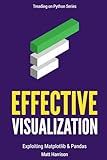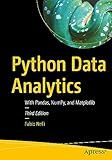Best Books to Learn Matplotlib to Buy in December 2025

Data Visualization in Python with Pandas and Matplotlib



Numerical Python: Scientific Computing and Data Science Applications with Numpy, SciPy and Matplotlib



Matplotlib 3.0 Cookbook: Over 150 recipes to create highly detailed interactive visualizations using Python



Effective Visualization: Exploiting Matplotlib & Pandas (Treading on Python)



Python Data Analytics: With Pandas, NumPy, and Matplotlib



Matplotlib 2.x By Example: Multi-dimensional charts, graphs, and plots in Python


To create a scatter plot in Matplotlib, you can follow these steps:
First, import the necessary libraries:
import matplotlib.pyplot as plt import numpy as np
Next, create some data points for the x and y coordinates:
x = np.array([1, 2, 3, 4, 5]) y = np.array([10, 15, 13, 7, 20])
Then, use the scatter() function to create the scatter plot:
plt.scatter(x, y)
Customize the plot by adding labels to the x and y axes, as well as a title:
plt.xlabel('X-axis') plt.ylabel('Y-axis') plt.title('Scatter Plot')
Finally, display the scatter plot:
plt.show()
This will create a scatter plot with the given data points and display it using Matplotlib.
How to import the Matplotlib library in Python?
To import the Matplotlib library in Python, you can use the following code:
import matplotlib.pyplot as plt
Here, matplotlib.pyplot is a sub-module of the Matplotlib library commonly used for creating visualizations in Python. By importing it as plt, you can refer to its functions and classes more conveniently.
What is the command to save a scatter plot as an image file?
In most programming languages and data visualization libraries, you can save a scatter plot as an image file using the savefig() function or method.
Here is an example using Python and the popular data visualization library Matplotlib:
import matplotlib.pyplot as plt
Generate some data
x = [1, 2, 3, 4, 5] y = [2, 4, 6, 8, 10]
Create a scatter plot
plt.scatter(x, y)
Save the scatter plot as an image file
plt.savefig('scatter_plot.png')
In this example, plt.scatter() is used to create a scatter plot, and plt.savefig() is used to save the plot as an image file with the file name 'scatter_plot.png'.
What is the command for rotating the x-axis tick labels in Matplotlib?
The command for rotating the x-axis tick labels in Matplotlib is plt.xticks(rotation=<angle>), where <angle> is the desired rotation angle in degrees.
For example, to rotate the x-axis tick labels by 45 degrees, you can use the following command:
import matplotlib.pyplot as plt
... previous code ...
plt.xticks(rotation=45)
plt.show()
This will rotate the x-axis tick labels by 45 degrees.
How to remove the border around a scatter plot?
To remove the border around a scatter plot, you need to adjust the properties of the plot itself or the plot area. Here are two methods to achieve this:
- Adjust the plot properties: If you are using a software or library that offers plot customization, such as matplotlib in Python or ggplot2 in R, you can modify the plot properties directly. Typically, you can use a function or method like plt.scatter() or geom_point() and set the edgecolor parameter to "none" or "transparent". Here is an example using matplotlib in Python: import matplotlib.pyplot as plt x = [1, 2, 3, 4, 5] y = [1, 4, 9, 16, 25] plt.scatter(x, y, edgecolor='none') # or edgecolor='transparent' plt.show() If you are using a web-based plotting tool, check if it provides options to customize plot properties, including the scatter plot's border. Look for properties like "border" or "stroke" and set them to "none" or "transparent".
- Adjust the plot area properties: If you want to remove the border around the entire scatter plot area, rather than the individual points, you can adjust the plot area properties. Again, this depends on the software or library you are using, but common options include adjusting the figure or plot area's border properties. Here is an example using matplotlib in Python: import matplotlib.pyplot as plt x = [1, 2, 3, 4, 5] y = [1, 4, 9, 16, 25] plt.scatter(x, y) plt.gca().spines['top'].set_visible(False) plt.gca().spines['bottom'].set_visible(False) plt.gca().spines['right'].set_visible(False) plt.gca().spines['left'].set_visible(False) plt.show() For web-based tools, look for options to customize the plot area's border or frame and set it to "none" or "transparent".
Remember to adjust the code according to your specific requirements and the tool or library you are using.
How to adjust the spacing between data points in a scatter plot?
To adjust the spacing between data points in a scatter plot, you can follow these steps:
- Determine the axes limits: Ensure that the axes limits of your scatter plot are appropriate for the range of data you want to display. You can modify the limits using the appropriate functions or methods based on the software or programming language you are using.
- Specify the marker size: Increase or decrease the size of the markers used to represent each data point. This will depend on the software or programming language you are using, but typically there will be an option to adjust the marker size. Increasing the marker size will lead to data points being more spread out, while decreasing it will make data points closer together.
- Adjust the marker style: Another approach is to modify the marker style used in the scatter plot. Some software or programming languages offer different marker styles such as circles, squares, triangles, etc. You can experiment with different marker styles to see which provides the desired spacing.
- Increase the figure size: If the above steps don't give you enough control over the spacing, you can try increasing the size of the figure or plot area. This will allow more space for data points to be displayed and might result in a more spread out appearance. Again, the process to adjust the figure size will depend on the software or programming language being used.
Keep in mind that the options and steps for adjusting scatter plot spacing may vary depending on the software or programming language you are using. Therefore, consult the documentation or resources specific to your chosen tool for more detailed instructions.
How to add error bars to a scatter plot?
To add error bars to a scatter plot, you can follow these steps:
- Create your scatter plot.
- Calculate the values of your error bars. This will depend on the specific data you are working with. Common ways to calculate error bars include standard deviation, standard error, or confidence intervals.
- Add the error bars to your plot. There are different ways to do this depending on the software you are using, but here are a few common methods for popular plotting libraries:
- Matplotlib (Python): You can use the errorbar function to add error bars to a scatter plot. Provide the x and y coordinates for the data points, as well as the values of the error bars. Here's an example:
import matplotlib.pyplot as plt
x = [1, 2, 3, 4, 5] y = [2, 4, 6, 8, 10] error = [0.5, 0.3, 0.8, 0.4, 0.7]
plt.scatter(x, y) plt.errorbar(x, y, yerr=error, fmt='o') plt.show()
- ggplot2 (R): You can use the geom_errorbar function to add error bars to a scatter plot. Provide the x and y coordinates for the data points, as well as the values of the error bars. Here's an example:
library(ggplot2)
x <- c(1, 2, 3, 4, 5) y <- c(2, 4, 6, 8, 10) error <- c(0.5, 0.3, 0.8, 0.4, 0.7)
df <- data.frame(x = x, y = y, error = error)
ggplot(df, aes(x = x, y = y)) + geom_point() + geom_errorbar(aes(ymin = y - error, ymax = y + error), width = 0.2)
- Excel: Select your scatter plot, go to the "Chart Design" or "Layout" tab, and look for the "Error Bars" option. Choose the appropriate setting to add error bars based on your data.
These examples show basic setups for adding error bars to scatter plots. You can further customize the appearance and style of the error bars based on your requirements or the available options in the plotting library or software you are using.
